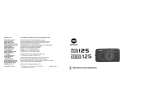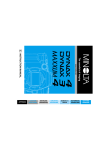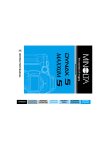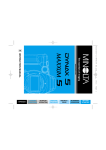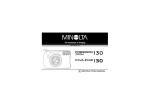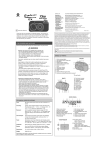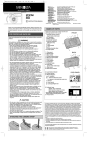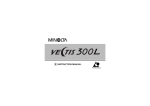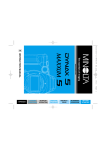Download Minolta FREEDOM ZOOM 150 Instruction manual
Transcript
2463_English 2/14/00 1:21 PM Page 1 1 2463_English 2/14/00 1:21 PM Page 2 FOR PROPER AND SAFE USE Read and understand all warnings and cautions before using this product. WARNING Batteries may become hot or explode due to improper use. • Use only the batteries specified in this instruction manual. • Do not install the batteries with the polarity (+/–) reversed. • Do not subject batteries to fire or high temperatures. • Do not attempt to recharge, short, or disassemble. • Tape over lithium battery contacts to avoid short-circuit when disposing of batteries, and follow local regulations for battery disposal. Keep batteries or things that could be swallowed away from young children. Contact a doctor immediately if an object is swallowed. Immediately remove the batteries and discontinue use if... • the camera is dropped or subjected to an impact in which the interior is exposed. • the product emits a strange smell, heat, or smoke. Do not disassemble. Electric shock may occur if a high voltage circuit inside the camera is touched. Take your camera to a Minolta Service Facility when repairs are required. CAUTION The lens retracts when the camera is turned off or Auto Power Off is activated. Touching the lens barrel while it is retracting may cause injury. 1 2463_English 2/14/00 1:21 PM Page 2 TABLE OF CONTENTS Thank you for purchasing this Minolta camera. Your new camera is equipped with functions which will suit your every photographic need. Before using your new camera, please take the time to read through this instruction manual for it contains important information on the use and care of your camera. For Proper and Safe Use ...........2 Name of Parts ............................4 Inserting the Battery ...................8 Battery Condition Indicator .........9 Loading the Film.........................10 Full-Auto Operation ....................12 For Closer Subjects....................16 Special Focusing Situations .......18 Focus Hold .................................20 Rewinding the Film.....................22 Selecting the Flash Mode...........24 Using the Built-in Flash ..............25 Flash Lamp ...........................25 Flash Range..........................26 Autoflash with Red-eye Reduction ...................27 Fill Flash .....................................28 Flash Cancel...............................29 Night Portrait Mode ....................30 Exposure Compensation Mode ..32 Selecting Additional Features.....34 Self-timer ....................................35 Continuous Drive ........................37 IR Remote Control RC-3 ............39 For Owners of the Quartz Date Model................46 Imprinting the Date or Time ..47 Setting the Date and Time ....48 Changing the Format ............50 Camera Strap .............................52 Care and Storage .......................54 Technical Details.........................58 2 3 2463_English 2/14/00 1:21 PM Page 4 NAME OF PARTS Data panel BODY Meter window* Viewfinder window* Drive-mode/Adjust button AF window* Remote-control receiver* Date button (Quartz Date model only) Flash* Shutter-release button Flash-mode/Select button Main switch Lens* Strap eyelet Back-cover release (10) Panorama switch (Panorma model only) Self-timer/ Remote-control lamp* Tripod socket Manual-rewind button (23) * Do not touch 4 Viewfinder* Battery-chamber door (8) Back cover Film window Zoom lever (13) For information on specific parts, refer to the page numbers shown in parenthesis. Continued on next page. 5 2463_English 2/14/00 1:21 PM Page 6 NAME OF PARTS DATA PANEL Date/Time display (Quartz Date model only) VIEWFINDER Remote-control indicator♦ ♦The remote control (RC-3) is sold separately. Battery-condition indicator Frame counter Flash mode indicators Autoflash Autoflash with red-eye reduction Fill-flash Flash cancel Night Portrait (with red-eye reduction) Exposure Compensation 6 Film-transport signals Cartridge mark Close-framing guide (16) Focus lamp (green) With the shutter-release button pressed partway down Glows: Focus confirmed Blinks quickly: Subject is too close Blinks slowly: Contrast too low Flash lamp (orange) With the shutter-release button pressed partway down Glows: Flash will fire Blinks quickly: Flash charging Blinks slowly: Camera-shake warning Continuous-drive indicator Self-timer indicator Focus frame 7 2463_English 2/14/00 1:21 PM Page 8 INSERTING THE BATTERY Your camera uses one 3-volt CR123A or DL123A lithium battery to supply power for all camera operations. 1. Open the battery-chamber door using the bigger key included on the strap. 2. Insert the battery according the + and – marks inside the battery chamber, then snap the door closed. • Quartz Date model: The date and time must be reset (p. 48). 8 BATTERY CONDITION INDICATOR Each time the camera is turned on, a symbol will appear in the data panel to indicate the power status of the battery. Briefly appears. Power is sufficient for all camera operations. Power is sufficient, but the battery must be replaced soon. Replace the battery. The shutter will lock until the battery is replaced. 9 2463_English 2/14/00 1:21 PM Page 10 LOADING THE FILM Use only 35mm, DX-coded film rated ISO 25 to 3200. • ISO 400 film is recommended for best results. • Always load and unload film in subdued light. • Do not use Polaroid instant 35mm film. Winding problems may occur. 2. Extend the film tip to the "FILM TIP" mark, making sure it lays flat. OK 1. Slide the back-cover release down to open the back cover, then place the film cartridge into the film chamber. • Once the film is loaded, the back cover will lock until the film rewinding is complete, preventing accidental opening. If the release lever is slid to the open position, “CLOSEd” will appear in the data panel. 10 3. Close the back cover. • The film automatically advances to the first frame and appears in the data panel. • If the film has been loaded improperly, will blink in the data panel and the shutter will remain locked. Open the back cover and repeat the loading procedure. 11 2463_English 2/14/00 1:21 PM Page 12 FULL-AUTO OPERATION 1. Press the main switch to turn the camera on. • Auto Power Off: To conserve power, the camera automatically turns off if it is not operated for more than 8 minutes. 2. Hold the camera steady, making sure your fingers do not cover the flash, lens, or AF window. • For vertically framed pictures, hold the camera so the flash is on top. • Dots under the flash function as a guide to prevent accidental shielding of the flash with a finger. • Do not obstruct or hold the camera using the lens barrel. 12 3. Look through the viewfinder and push the zoom lever T (telephoto) to zoom in or W (wide angle) to zoom out. 4. Place the focus frame on a detailed part of the subject and press the shutter-release button partway down. Continued on next page. 13 2463_English 2/14/00 1:21 PM Page 14 FULL-AUTO OPERATION (4. continued from page 13). • The AF illuminator (flash) will fire in low light to determine focus distance. • The flash will fire automatically in low-light and back-lit situations. • When the orange lamp blinks rapidly, the flash is charging. Wait until it glows steadily, then take the picture. • When the green lamp blinks rapidly, you are too close to the subject. (See page 16-17). 14 5. When the green focus lamp glows, press the shutter-release button all the way down to take the picture. • The film automatically advances to the next frame. 15 2463_English 2/14/00 1:21 PM Page 16 FOR CLOSER SUBJECTS Close-framing guide Viewfinder image When taking a picture with the subject closer than 1.7m (5.6 ft.), the viewfinder image and the actual film image is going to be different. The difference increases as the subject becomes closer, or when taking telephoto pictures. At the closest range, the top of the actual film image is located below the close framing guide. If the subject is closer than 1.7m (5.6 ft.), take the following steps. 1. Place the focus frame on the subject and press the shutter release button partway down. 2. While pressing the shutter-release button partway down, aim the camera upward. Recompose the subject under the close-framing guide and take the picture. Actual image (shaded area) • When taking pictures at extremely close distances, the green focus lamp may blink slowly, but the focus may not be accurate. • If the green focus lamp blinks rapidly and the shutter locks, the subject is too close. Be sure your camera-to-subject distance is at least 60 cm (W), 85 cm (T). 16 Actual print 17 2463_English 2/14/00 1:21 PM Page 18 SPECIAL FOCUSING SITUATIONS Some scenes or subjects, like the examples below, are difficult for the autofocus system to lock on to. When the focus will not lock, focus hold (p. 20) on another object the same distance from you as your main subject, recompose, then take the picture. When your subject is near a very bright object or area. When a very bright or low contrast area fills the focus frame. When a subject composed of alternating light and dark lines fills the focus frame. The green focus lamp will blink slowly to warn you that focus may not be accurate. Focus will be set to infinity without flash and between 3 - 6m (9.9 - 19.8 ft.) with flash. When two subjects overlap in the focus frame. 18 19 2463_English 2/14/00 1:21 PM Page 20 FOCUS HOLD Subjects outside the focus frame may not be in focus. Use focus hold to ensure accurate focusing. 2.Press and hold the shutter-release button partway down until the green focus lamp glows. 1. Place the focus frame on your subject. 3. Without lifting your finger, recompose the picture and press the shutter-release button all the way down to take the picture. • Lift your finger from the shutter-release button to cancel focus hold. 20 21 2463_English 2/14/00 1:21 PM Page 22 REWINDING THE FILM Your camera automatically rewinds the film after the last exposure is taken. When blinks in the data panel, open the back cover and remove the film. • Do not open the back cover until blinks in the data panel. Never use force. MANUAL REWIND To begin rewind before the end of the roll, turn the camera on and press the manualrewind button using the smaller button key on the strap. Once the film is loaded, the back cover will lock until the film rewinding is complete, to prevent the back cover from being opened accidentally. If the back cover release lever is slid to the open position, “CLOSEd” will appear in the data panel. If rewind stops before the film has been completely rewound, all the indicators will blink. Insert a fresh battery, then press the manual-rewind button. 22 23 2463_English 2/14/00 1:21 PM Page 24 SELECTING THE FLASH MODE Press the flash-mode button until the desired indicator appears in the data panel. USING THE BUILT-IN FLASH FLASH LAMP (ORANGE) The orange flash lamp comes on when the shutterrelease button is pressed partway down. • The flash lamp will glow when the built-in flash is ready. • When the orange flash lamp blinks rapidly, the flash is charging. Wait until it glows steadily, then take the picture. Autoflash ,autoflash with red-eye reduction , fill flash , flash cancel , night portrait , and exposure compensation mode can be selected. 24 25 2463_English 2/14/00 1:21 PM Page 26 USING THE BUILT-IN FLASH AUTOFLASH WITH RED-EYE REDUCTION When you turn the camera on, the built in flash is automatically set to autoflash or autoflash with red-eye reduction, whichever was used last. In these modes, the flash will fire automatically in low-light and back-lit situations. ISO 100 ISO 400 0.6 - 9.2m 0.6 - 4.6m 37.5mm 2.0 - 15.2 ft. 2.0 - 30.4 ft. 150mm 26 0.85 - 2.0m 0.85- 4.0m 2.8 - 6.6 ft. 2.8 - 13.2 ft. Use the built-in flash's red-eye reduction mode to reduce the red-eye effect when photographing people or animals in low-light situations. The flash will fire a few short bursts before the main flash burst to reduce the red-eye effect. FLASH RANGE The range of the built-in flash depends on the film speed and focal length you are using. To ensure proper exposure, make sure your subject is positioned within the flash range. Pre-flash Main Flash Press the flash-mode button until appears in the data panel, then take the picture. • Warn your subject the flash will fire a few short bursts just before the picture is taken. 27 2463_English 2/14/00 1:21 PM Page 28 FILL FLASH FLASH CANCEL The flash will fire when the shutter is released regardless of lighting. Use fill flash to reduce harsh shadows on your subject's face. The flash will not fire in this mode. Flash cancel should be used when photographing twilight scenes or subjects beyond the flash range. Press the flash-mode button until appears in the data panel, then take the picture. Press the flash-mode button until appears in the data panel, then take the picture. • Shutter speed will most likely be slow and the use of a tripod is recommended. • When the flash lamp blinks slowly, your scene is too dark for a sharp hand-held picture. Use flash or place the camera on a tripod. 28 29 2463_English 2/14/00 1:21 PM Page 30 NIGHT PORTRAIT MODE In night portrait mode, the camera balances the flash and existing light exposure so you can take beautiful pictures of people at sunset or at night. 1. Press the flash-mode button until showing in the data panel. 2. Place the focus frame on the subject, then take the picture. • The shutter speed will most likely be slow. Use of a tripod is recommended and be sure to tell your subjects not to move. is • Fill flash with red-eye reduction will be set. 30 31 2463_English 2/14/00 1:21 PM Page 32 EXPOSURE COMPENSATION MODE Exposure Compensation is recommended when you are photographing snow scenes, beach scenes, backlit or spot-lit subjects, or scenes with a large amount of sky. Exposure compensation will increase the exposure by 1.5 EV (stops). • Flash will not fire. 2. Align your subject within the focus frame, then take the picture. 1. Press the flash-mode button until appears in the data panel. • When the shutter speed is slow, the orange lamp beside the viewfinder will blink slowly, warning you about camera shake. 32 33 2463_English 2/14/00 1:21 PM Page 34 SELECTING ADDITIONAL FEATURES You can select the self-timer or remote control mode. SELF-TIMER , continous drive , Press the drive-mode button until the desired symbol appears in the data panel. • When you turn the camera on, the camera is automatically set to the normal operating mode. Normal setting 34 The self-timer delays release of the shutter for approximately 10 seconds after you press the shutterrelease button. 1.Place the camera on a tripod, then press the drive-mode button until the self-timer symbol appears in the data panel. 2. Place the focus frame on your subject. Continued on next page. 35 2463_English 2/14/00 1:21 PM Page 36 SELF-TIMER (CONTINUED) 3. Press the shutter-release button all the way down. • will blink in the data panel. The self-timer lamp on the front of the camera will blink slowly during the countdown, then rapidly just before the shutter is released. • To cancel the self-timer, press the drive-mode button again or turn the camera off. • Self-timer is automatically cancelled after the shutter is released. CONTINOUS DRIVE In this mode, the camera continuously takes pictures and advances the film as long as the shutter-release button is held down. 1. Press the drive-mode button until the continous mode symbol appears in the data panel. ✎ The camera locks focus on the subject when the shutter-release button is pressed. Focus hold can be used (p. 20). 36 Continued on next page. 37 2463_English 2/14/00 1:21 PM Page 38 CONTINOUS DRIVE (CONTINUED) 2. Press and hold the shutter-release button all the way down. • Without flash, the shutter will release every 1.8 seconds; with flash, the shutter will release when the flash is charged. • Continuous drive mode remains selected after the series is complete. IR REMOTE CONTROL RC-3 (SOLD SEPARATELY) Your camera comes equipped to use the IR Remote Control RC-3 (sold separately). The IR Remote Control RC-3 allows remote camera operation up to 5 meters (16.5 feet) away. Before using the remote control, please read the instructions throughly. A NAMES OF PARTS (A) 1. Emitter window 2. Delay button 3. Release button 4. Battery cover 38 Continued on next page. 39 2463_English 2/14/00 1:21 PM Page 40 IR REMOTE CONTROL RC-3 (SOLD SEPARATELY) TAKING THE PICTURE B 1. Place the camera on a tripod, press the drive-mode button until appears in the data panel (B). C 3. Point the remote control toward the front of the camera and press either the release button or the delay button (C). • If your camera has Panorama function and you will be taking a panorama photo, be sure to select the panorama mode before placing on a tripod. 2. Place the focus frame on your subject. 40 • If the release button (•) is pressed, the self-timer/remote-control lamp on the front of the camera will blink once before the picture is taken. If the delay button (2s) is pressed, the self-timer/remote-control lamp on the front of the camera will blink for two seconds before the picture is taken. Continued on next page. 41 2463_English 2/14/00 1:21 PM Page 42 IR REMOTE CONTROL RC-3 (SOLD SEPARATELY) • To save power, the camera automatically shuts down and the lens retracts if the shutter is not released in approximately 8 min. • The distance may be shorter or the remote control may not operate with backlit subjects, under fluorescent light, or in extremely bright lighting conditions. CANCELLATION The remote control mode will remain selected after the picture has been taken. Press the drive-mode button to delete the remote-control icon, or turn the camera off. FOCUS HOLD IN REMOTE CONTROL MODE When your subject is not in the center of the picture, use focus hold (p20 in the camera manual) 1. Select remote-control mode on the camera. 2. Center the focus frame on your subject, adjust zoom as desired, then press and hold the camera’s shutter-relaease button partway down until the green focus lamp glows. 3. Lift your finger from the shutter-release button, then recompose the picture. 42 Continued on next page. 43 2463_English 2/14/00 1:21 PM Page 44 IR REMOTE CONTROL RC-3 (SOLD SEPARATELY) 4.Point the remote control toward the front of the camera, press either the Release button (•) or Delay button (2s). CHANGING THE BATTERY D • After the picture has been taken, focus will remain locked. To cancel focus hold, turn the camera off, or operate the zoom lever. E 44 The remote control uses a 3V lithium battery (CR2032). When pressing the remote-control buttons does not release the shutter, the battery must be replaced. (The supplied battery should be sufficient for approximately ten years of operation). 1. Pull out the battery chamber and remove the old battery (D). 2. Insert a new battery into the battery chamber with its plus side up (E). 3. Slide the battery chamber back into the remote control. 45 2463_English 2/14/00 1:21 PM Page 46 FOR OWNERS OF THE QUARTZ DATE MODEL This feature enables you to record the date or time onto the lower-right portion of the picture. The automatic calendar is through the year 2029. IMPRINTING THE DATE OR TIME • The date is recorded as the film is advanced to the next frame. Sometimes the last frame of the roll will not have a date imprint. Turn the camera on, then press the DATE button to choose the data imprinting format. • The display will change as follows. BUTTONS FOR DATE FUNCTION 1. SEL (Select) button. 2. ADJ (Adjust) button. 3. DATE button. DATE TIME / DAY -- -- -- (no display) • When -- -- -- is displayed in the data panel, no data will be printed. • If the date-time display is blinking, date/time information will not be imprinted. The date/time information needs to be reset (see page 48). 46 Continued on next page. 47 2463_English 2/14/00 1:21 PM Page 48 FOR OWNERS OF THE QUARTZ DATE MODEL SETTING THE DATE OR TIME Note: The date and time must be reset each time the batteries are replaced. 1. Turn the camera off, then press the DATE button to display the date. 2. Press the SEL button until the item you want to adjust blinks. • Each press of the select button causes the next item to blink. The sequence is: YY 48 MM DD hh mm 3. Press the ADJ button to change the blinking item. • Data continues changing as long as the button is held down. 4. Repeat steps 2 and 3 until all items in the date and time display are correct. 5. Press the SEL button until all items stop blinking to set the updated information. stops blinking Continued on next page. 49 2463_English 2/14/00 1:21 PM Page 50 FOR OWNERS OF THE QUARTZ DATE MODEL CHANGING THE FORMAT 50 1. Press the main switch to turn the camera off. 4. Press the ADJ button to change the display format. 2. Press the DATE button to display the date. • The format sequences as follows: `Y M D M D`Y D M`Y 3. Press and hold the SEL button until all items in the date display blink. 5. Press the SEL button until all items stop blinking to set the updated information. 51 2463_English 2/14/00 1:21 PM Page 52 CAMERA STRAP CARE AND STORAGE OPERATING TEMPERATURE AND CONDITIONS Attach the strap as shown. Button keys 52 • Button keys are included on the strap. Use the bigger key to turn the battery chamber lock, smaller key to push the manual-rewind button. • This camera is designed for use from -10 to 40 °C (14 to 104 °F). • Never leave your camera where it may be subjected to extreme temperatures such as in the glove compartment of a car. • At colder temperatures, the data panel response time will be slow. At higher temperatures, the display will temporarily darken, but will restore when the temperature normalizes. Continued on next page. 53 2463_English 2/14/00 1:21 PM Page 54 CARE AND STORAGE CLEANING Never subject the camera to extreme humidity. • To prevent condensation from forming, place the camera in a sealed plastic bag when bringing it from a cold environment into a warm environment. Allow it to come to room temperature before removing it from the bag. • When photographing in cold weather, it is recommend that you keep the camera and spare batteries inside your coat to keep them warm when you are not shooting. Cold batteries will regain some of their charge when they warm up. • This camera is not waterproof, dustproof, or sand-proof. If you use this camera near water or the beach, water-, dust-, or sand-damage may occur. Protect it at all times from moisture or splashes, especially saltwater spray, and be extremely careful to keep sand from both the interior and exterior of the camera and its accessories. 54 • Keep the AF window clean or the focus may not be accurate. • If the camera body is dirty, gently wipe it clean with a soft, clean, dry cloth. • To clean the lens surface, first brush away any dust or sand then, if necessary, moisten a lens tissue with lens cleaning fluid and gently wipe the lens in a circular motion, starting from the center. • Never place lens fluid directly on the lens. • Never touch the lens surface with your fingers. • Never use alcohol or solvents to clean the camera. Continued on next page. 55 2463_English 2/14/00 1:21 PM Page 56 CARE AND STORAGE STORAGE QUESTIONS AND SERVICE When storing the camera for extended periods, please follow these guidelines: • Store the camera in a cool, dry, well-ventilated area away from dust and chemicals. For very long periods, place the camera in an airtight container with a silica gel drying agent. • Before using after prolonged storage, always check the camera’s operation to make sure it is functioning properly. • If you have questions about your camera, contact your local camera dealer or write to the Minolta distributor in your area. • Before shipping your camera for repair, please contact an authorized Minolta Service Facility for details.. BEFORE IMPORTANT EVENTS CAMERA ERROR • Check camera operation carefully or take test photographs. • Minolta is not responsible for any loss which may occur due to an equipment malfunction. If all the indicators in the data panel blink, or the data panel is blank and the camera will not function with a fresh battery, remove and reinsert the battery. If normal operation does not resume, or the camera malfunctions repeatedly, contact an authorized Minolta Service Facility. 56 57 2463_English 2/14/00 1:21 PM Page 58 TECHNICAL DETAILS Camera Type: Lens: 35mm lens-shutter camera 37.5-150mm f/5.4 - 11.9 lens 6 element/6 group construction Focusing Range:(W): 0.6m - ∞ (2.0 ft. - ∞)/ (T): 0.85 - ∞ (2.8 ft. - ∞) ISO Range: Your camera uses 35mm, DX-coded film rated ISO 25 to 3200. Metering Range (ISO 100): Wide: EV 3 - 17 Tele: EV 4 - 17 Flash Range (ISO 100): Wide: 0.6 - 4.6m (2.0 - 15.2 ft.) Tele: 0.85 - 2.0m (2.8 - 6.6 ft.) 58 Battery: One 3-volt CR123A lithium battery Battery-condition indication: 3-stage indication Battery performance: approx. 12 rolls based on Minolta's standard test method using 24 exposure rolls with flash for 50% of the exposures. Viewfinder: Magnification: 0.4X - 1.42X Field of View : 86% (subject at 3m) Eye-relief: 15.9mm from the viewfinder frame Dimensions: 112 x 60 x 44 mm 5.1 x 2.7 x 2.0 in Weight: 190g (6.7 oz.) without battery Specifications are based on the latest information available at the time of printing and are subject to change without notice. 59 2463_English 2/14/00 1:21 PM Page 60 This device complies with Part 15 of the FCC Rules. Operation is subject to the following two conditions: (1) This device may not cause harmful interference, and (2) this device must accept any interference received, including interference that may cause undesired operation. Changes or modifications not approved by the party responsible for compliance could void the user's authority to operate the equipment. This equipment has been tested and found to comply with the limits for a Class B digital device, pursuant to Part 15 of the FCC Rules. These limits are designed to provide reasonable protection against harmful interference in a residential installation. This equipment generates, uses and can radiate radio frequency energy and, if not installed and used in accordance with the instructions, may cause harmful interference to radio communications. However, there is no guarantee that interference will not occur in a particular installation. If this equipment does cause harmful interference to radio or television reception, which can be determined by 60 turning the equipment off and on, the user is encouraged to try to correct the interference by one or more of the following measures: • Reorient or relocate the receiving antenna. • Increase the separation between the equipment and the receiver. • Connect the equipment to an outlet on a circuit different from that to which the receiver is connected. • Consult the dealer or an experienced radio/TV technician for help. This Class B digital apparatus complies with Canadian ICES-003. This mark on your camera certifies that this camera meets the requirements of the EU (European Union) concerning interference causing equipment regulations. CE stands for Conformité Européenne (European Conformity). 61 2463_English 2/14/00 1:21 PM Page 62 Minolta Co., Ltd. 3-13, 2-Chome, Azuchi-Machi, Chuo-Ku, Osaka 541-8556, Japan Minolta Europe GmbH Minolta France S.A. Minolta (UK) Limited Minolta Austria Ges. m.b.H. Minolta Camera Benelux B.V. Belgium Branch Minolta (Schweiz) AG Minolta Svenska AB Finland Branch Minolta Portugal Limitada Minolta Corporation Head Office Los Angeles Branch Minolta Canada Inc. Head Office Vancouver Branch Minolta Hong Kong Limited Minolta Singapore (Pte) Ltd. Shanghai Minolta Optical Products Co., Ltd. Kurt-Fischer-Strasse 50, D-22923 Ahrensburg, Germany 365 Route de Saint-Germain, F-78420 Carrieres-Sur-Seine, France 7 Tanners Drive, Blakelands, Milton Keynes, MK14 5BU, England Amalienstrasse 59-61, A-1131 Wien, Austria Zonnebaan 39, P.O. Box 6000, NL-3600 HA Maarssen, The Netherlands Prins Boudewijnlaan 1, B-2550 Kontich, Belgium Riedstrasse 6, CH-8953 Dietikon, Switzerland Albygatan 114, S-171 54 Solna, Sweden Niittykatu 6 PL 37, SF-02201 Espoo, Finland Av. do Brasil 33-A, P-1700 Lisboa, Portugal 9222-2463-11 P-A002 101 Williams Drive, Ramsey, New Jersey 07446, U.S.A. 11150 Hope Street Cypress, CA 90630, U.S.A. 369 Britannia Road East, Mississauga, Ontario L4Z 2H5, Canada 230-3771 Jacombs Road, Richmond, B.C. V6V 2L9, Canada Room 208, 2/F, Eastern Center, 1065 King’s Road, Quarry Bay, Hong Kong 10, Teban Gardens Crescent, Singapore 608923 368 Minolta Road, Songjiang, Shanghai, China © 2000 Minolta Co., Ltd. under the Berne Convention and Universal Copyright Convention Printed in Japan E INSTRUCTION MANUAL

































